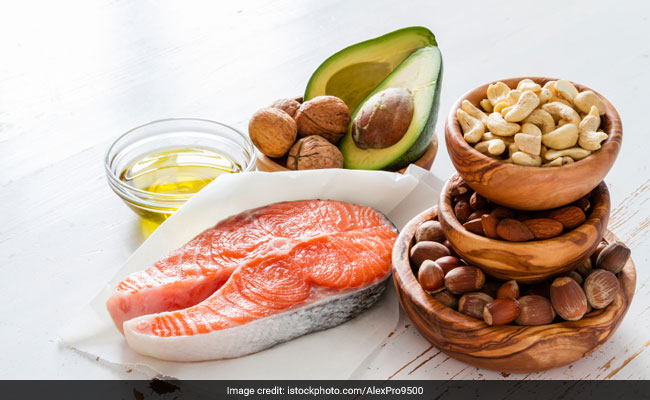
The term omega-3 most often refers to a group of fatty acids. There are two major types of omega-3 fatty acids in our diet: one type is alpha-linolenic acid (ALA), which is found in some vegetable oils, such as soybean, rapeseed (canola) and flaxseed, and in walnuts. ALA is also found in certain green vegetables, such as Brussels sprouts, kale, spinach and salad greens. The other type, eicosatetraenoic acid (EPA) and docosahexaenoic acid (DHA), is found in fatty fish. The body partially converts ALA to EPA and DHA. However, research clearly indicates that the conversion of ALA to EPA and DHA is extremely limited. Less than 5% of ALA gets converted to EPA, and less than 0.5% of ALA is converted to DHA. Hence, though it is a great idea to eat green leafy vegetables (which provide ALA), it is also important to consume fatty fish or supplements as a source of EPA and DHA.
Incredible Health Benefits Of Omega-3 Fatty Acids
Here are the numerous benefits of omega-3 fatty acids:
1. Lowers LDL cholesterol levels and reduces the risk of heart disease
2. Increases insulin sensitivity and reduces the severity of symptoms associated with diabetes
3. Reduces pain associated with rheumatoid arthritis
4. Reduces the risk of osteoporosis and bone loss
5. Improves health, better immune response and reduces the symptoms of autoimmune disease
6. Helps with anxiety and depression
7. Reduces the risk of various types of cancers
(Also read: 10 Incredible Health Benefits Of Black Seed Oil)

There are two major types of omega-3 fatty acids
8. Better nerve function and improves cognitive function
9. Better hormone function
10. Reduces inflammation and faster muscle recovery
11. Better kidney function and fluid balance
12. Increased energy production
13. Better oxygen use
14. Better cell growth and softer smoother skin
15. For conception and during pregnancy
The Ratio Is Important
Omega-3s are important, but what is even more important is consuming a healthy ratio of omega-6 (n-6) and omega-3 (n-3) fats. Both omega-3 and omega-6 fats are considered polyunsaturated fats because they have many double bonds. In general, we need much smaller amounts of these fats than we do other fats like saturated and monounsaturated fats, but they are still vitally important. Our bodies aren't able to produce polyunsaturated fats so we must get them from diet, this is the reason they are called "essential fatty acids".
(Also read: Benefits Of Raw Garlic For Health, Beauty: How To Use, Natural Remedies)

It is important to consume a healthy ratio of omega-6 (n-6) and omega-3 (n-3) fats
Omega-6 fats are found in many processed foods, vegetable oils, processed grains and soy. Omega-6 fats increase inflammation while omega-3 fats can help reduce inflammation. Since n-6 fats are present in many processed foods, it is easy to understand why most of us get plenty of these in our diets. In fact, many people get way too much in their diets.
The ideal ratio of omega-6 to omega-3 fats is thought to be around 1:1 (and not higher than 4:1). Most people are consuming much higher amounts of omega-6 fats (up to 30:1). Higher amounts of omega-6 can contribute to inflammation within the body and to disease. Hence it is imperative to increase omega-3 consumption with food and supplements and most importantly decrease omega-6 consumption.
Application Of Omega-3 Fats In Our Body
1. Fitness
Fat loss: Due to better insulin sensitivity, and higher thermogenic effect
Muscle gain: Due to better insulin sensitivity and overall better muscle recovery and nutrient uptake
2. Medical Conditions
Diabetic clients due to insulin sensitivity
Heart patients: Due to reduced BP, clotting and cholesterol

Omega-3 is essential for heart health
3. Nervous System Disorders :
RA: due to anti- inflammatory effect
Depression & ADHD: Due to better nerve signal transmission
Water retention/ menopause: due to improved fluid balance
A good way to optimise omega-3 benefits is to consume foods that are nutrient dense and adopt healthy lifestyle measures. Remember food is important to the body. It determines the quality of the cells, tissues and organs. Lifestyle is medicine. And when both these tools are incorporated meticulously in the body, they create healing properties.
Food Sources Of Omega-3
1. Indulge in healthy fats like avocado, olive oil, coconut oil, fatty fish , raw nuts and seeds
2. Whole unprocessed grains such as amaranth, brown rice and quinoa
3. High quality protein from eggs, lean meat, legumes and pulses

Eggs are a great source of omega-3
4. Adequate water
5. Regular exercise with good rest and recovery
6. 7-8 hours sleep
7. Reduce stress
8. Adequate vitamin D levels
About the author: Karishma Chawla is a Mumbai-based certified nutritionist and lifestyle educator specialising in gut and hormone health.
Disclaimer: The opinions expressed within this article are the personal opinions of the author. NDTV is not responsible for the accuracy, completeness, suitability, or validity of any information on this article. All information is provided on an as-is basis. The information, facts or opinions appearing in the article do not reflect the views of NDTV and NDTV does not assume any responsibility or liability for the same.
Track Latest News Live on NDTV.com and get news updates from India and around the world
